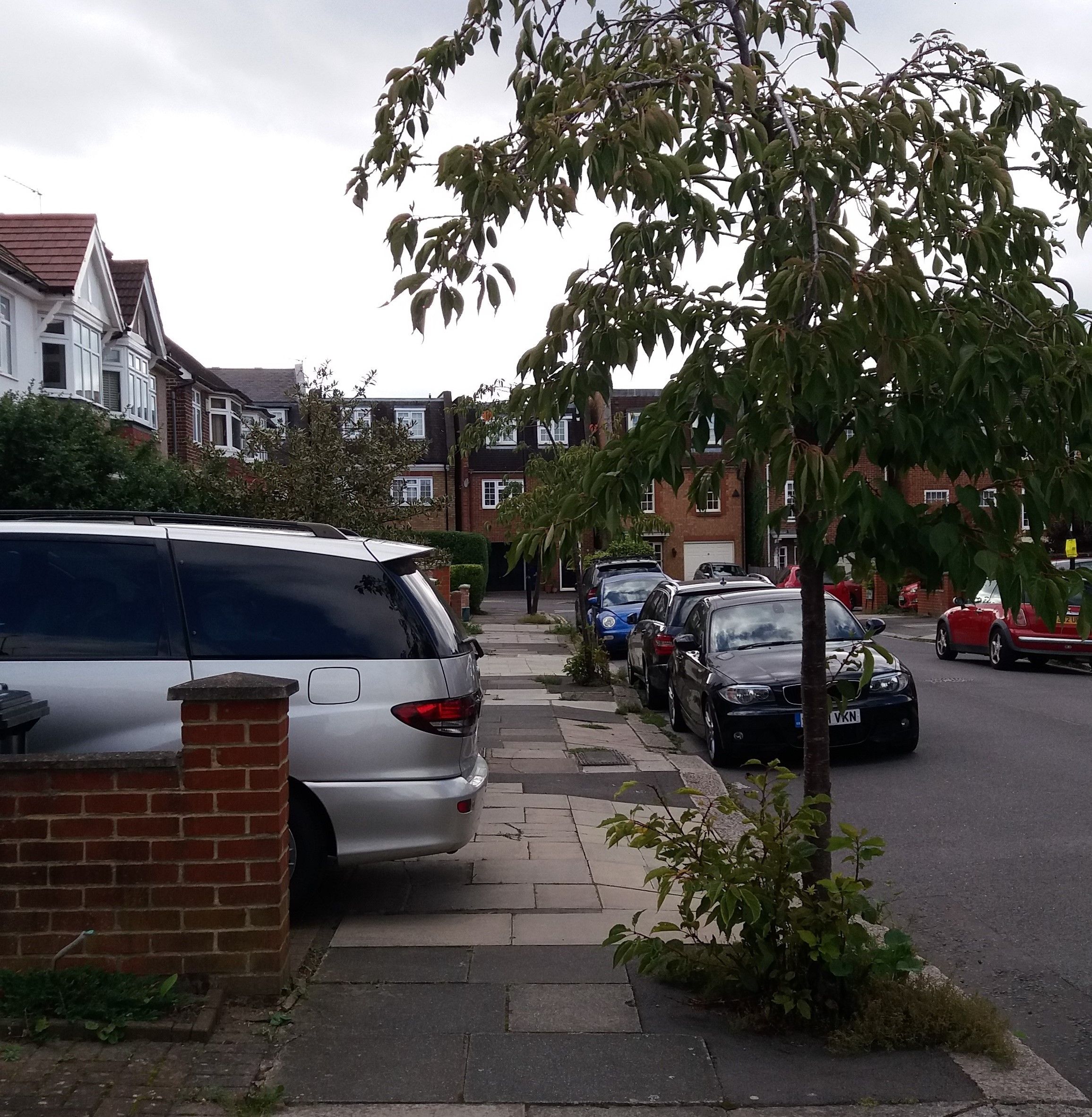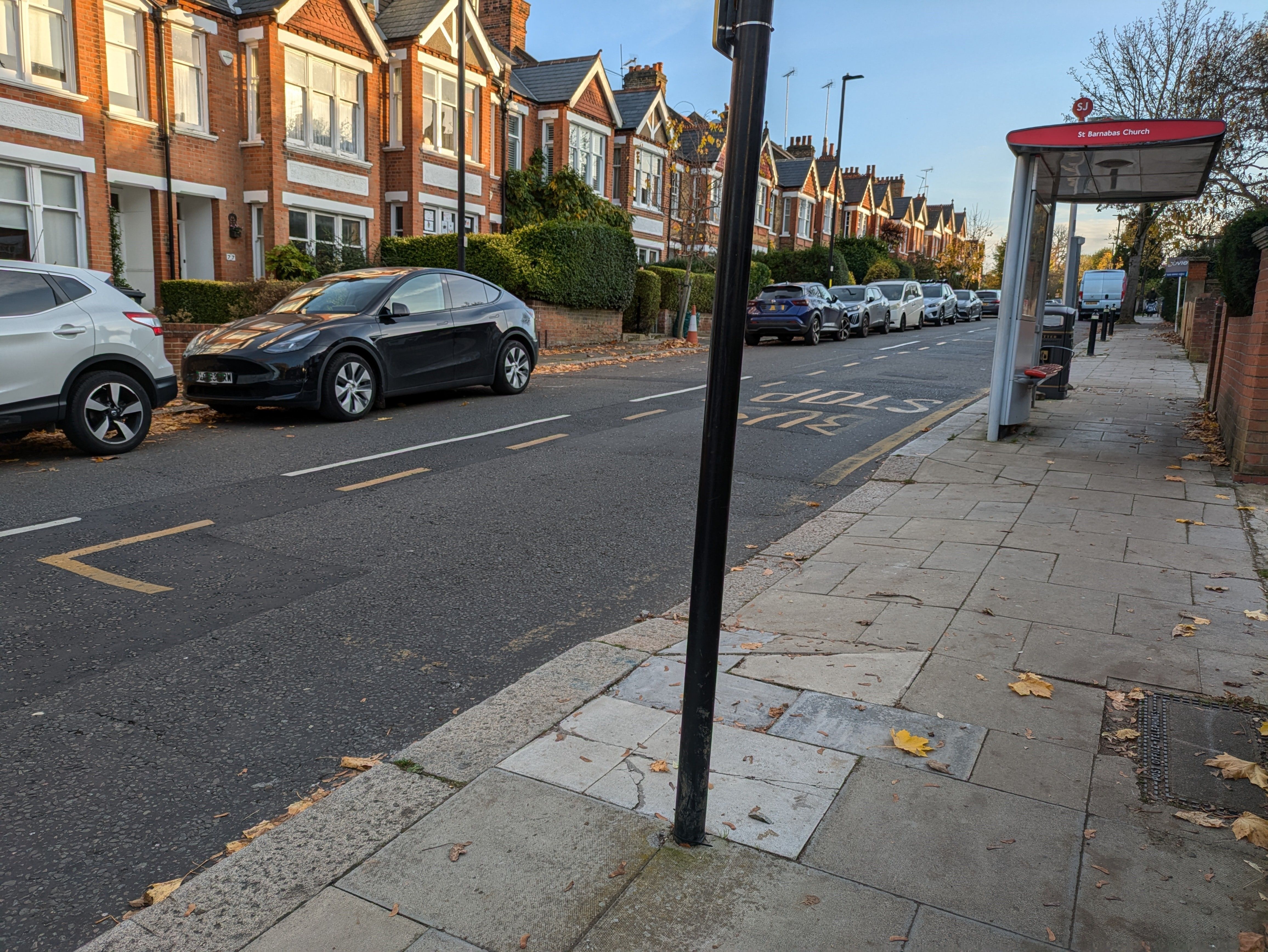
Pavement crossovers (kerb drops), which allow people to park in their front gardens, have been permitted development since 1995. Now, millions of the nation’s front gardens are car parks. Some residential streets have few original front gardens left. Some have no front gardens left at all.
The costs and consequences of this, from increased risk of health-harming heat and higher flood risk to loss of space for nature and community amenity, are increasingly stark. The lasting costs fall on everyone but households benefiting from crossovers don’t pay.

Domino Effect
Originally it was a popular move: people liked the idea of having space to park close to their houses, especially if they had more than one vehicle. But the effects on their neighbours quickly became apparent.
It’s often thought that parking on front gardens leaves space on the street for others to use. But because crossovers effectively remove a section of roadside parking, neighbours have less space to park their own vehicles.
Neighbours often react by also applying for crossovers leading to even less space for roadside parking. So, more crossover applications are made until entire streets have scarcely any roadside parking left. In some places this pattern or Domino Effect happened within a decade.

Controlled Parking Zones (CPZs) and residents’ parking schemes further complicate the picture. When local authorities introduce CPZs to reserve the remaining parking for residents, the annual residents’ parking charge often encourages yet more crossover applications, as householders seek to avoid paying it by parking in their front gardens.
These households effectively get a free ride – having the benefits of living in a CPZ without making any contribution to its costs. At the same time space for roadside parking to other car users is reduced. This effectively creates pressure and often a further incentive for more front gardens to be paved for parking – continuing the Domino effect.
Some householders may even make (tax-free) money by renting out up to two parking spaces in their front garden or driveway for commuter parking.

Effects on walking
Crossovers also make life difficult for people to walk. They make the pavement uneven, so that pushing buggies and wheelchairs, driving mobility scooters, wheeling shopping and luggage and walking two-abreast is more challenging.
Constantly being driven over often cracks the pavement and makes it uneven. And cars parked in front gardens sometimes encroach onto the pavement, causing obstruction – this is increasingly common as vehicles get bigger and bigger.

Local authority street management
Crossovers are also challenging for local authorities. They seriously reduce the amount of on-street parking available in the entire area, potentially leading to parking pressures and congestion elsewhere. They create costly damage to pavements by being constantly driven over – especially by electric vehicles and SUVs which are heavier than standard cars.

Crossovers restrict where neighbourhood essentials like lamp posts, road drains, street signage, residents’ parking bays, electric vehicle charging points, cycle parking, pedestrian crossings and bus stops can be put.

They also restrict where street trees, green verges, rain gardens and kerb build-outs can be positioned. As cities get hotter we will need more of all these things.


What to do?
Paving over front gardens causes lots of problems. Surface water flooding and excess heat in urban areas are the most high profile, but there are many other (see previous blogs).
In 2024 The London Climate Resilience Review suggested “introducing stormwater charges for people who pave over gardens” and in 2023 Ofwat suggested reducing water bills for households that don’t pave or have “permeable driveways”. In both cases there was a backlash from motorists.
But such measures would probably be very difficult to specify, agree and enforce. Householders would say, with some justification, that they have followed Government regulations, and there would also be a backlash from garden contractors and paving manufacturers.
One approach could be an annual charge on pavement crossovers – which are actually public property.
Crossovers provide households with cars with many benefits: free parking, avoidance of residents’ parking charges, opportunities to make money from commuters. Once approved and installed (the cost usually charged to the householder), they effectively privatise the bit of road beside the crossover: the household has sole use and no-one else can use it at all.
No-one else benefits: those who have to park on street and pay residents’ charges for doing so; non-car owning taxpayers; pedestrians; local traders, visitors and, in particular, local authorities trying to make streets liveable and manage parking.
Pavements and roadspace in particular are part of the ‘good’ public services which the local authority has to provide and maintain for the entire community. Crossovers, which are just for a minority, compromise this.
How might it work?
Government giving local authorities the powers to levy an annual charge on crossovers could be a way to open residents’ eyes to the impacts of their crossovers and the benefits they are getting. It would make crossovers recognised as a service, and redress the unfairnesses in the current approach. It should be straightforward to administer after initial data collection and might make householders think twice about whether they need front garden parking, or all the vehicles they have.
The funds raised could be used for reinstatement of unwanted crossovers, depaving projects and communications and projects about better front gardens.
It would also be very good if the funds were used for enforcement: of paved front gardens which do not conform to the regulations on run-off, of vehicles overhanging pavements and of illegal crossovers. This is where people illegally drive across the pavement to park in their front gardens. And of course it wouldn’t be surprising if some of the householders who decide to relinquish their crossovers rather than pay the annual charge carry on parking regardless – so local authorities would need to monitor this closely.


Charging for crossovers isn’t a complete solution, but it could be part of addressing the problem of so many front gardens being lost to hard surfacing. Many crossovers have been in place for years. But times have changed.
Climate change and biodiversity loss are now real threats, and we need to manage our cities and streets differently. This puts crossovers in a new light. We can now see that they are undermining efforts to improve local streets and make them more liveable and resilient to changing weather patterns.
